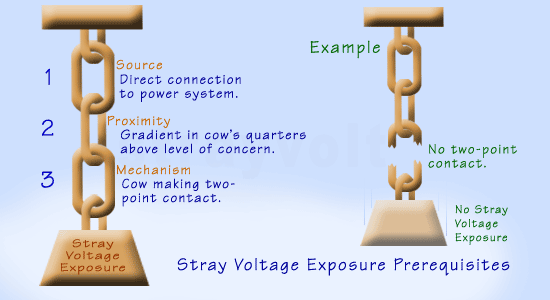Stray Voltage Exposure |
|
|
|
We have learned that the operation of electric power systems sometimes requires them to be connected to the earth to make them safe for people. We have also learned that wherever electrical systems are grounded for safety, some small voltage gradients may be added to other electric signals already present in the earth. The voltage gradients caused by electric power systems
on the surface of the earth [SV Origins] can be a
source of stray voltage for dairy cows [Gd Causes SV].
|
|
For a cow to actually experience stray voltage, a combination of circumstances must be present, called exposure. Stray voltage exposure is similar to the exposure of an individual to a virus. Exposure to the flu requires the presence of a source (an infected person), proximity (physical nearness of the source and the recipient of the virus), and a mechanism for the transmission of the virus (touching, sneezing by the infected party, etc.). Whether a person gets sick or not after exposure depends on his body's susceptibility to the virus.
|
 
|
|
Just because there are flu patients in a building, not every individual in the building will come down with the flu. Testing may show the presence of the virus at many locations in the building, but as long as a visitor is not exposed, he will not contract the flu. The voltage that may exist between a ground rod near the road and a point in the farmer's front yard is no more harmful to livestock than the 120 volts that exist between the wires in the farmhouse's bedroom wall outlet. These voltages cannot be perceived by the farm's animals, and are not harmful to them, because the animals do not come into contact with the two surfaces between which the voltage exists.
|
|
Many livestock farmers believe that their animals are being exposed to stray voltage if voltage or electrical current can be measured anywhere on their farm. This just isn't the case. Natural electric currents exist in the earth, just as viruses are always found in our environment. Connecting any electric measurement tools to the earth anywhere in the farm will
indicate electric presence. Is this related to the power stray voltage that a cow might experience? It is not possible to answer such a question without making appropriate measurements at meaningful locations, since it depends on exposure.
|
 
|
|
What constitutes stray voltage exposure for a cow? Just like virus exposure, stray voltage exposure requires source, proximity, and mechanism. If any of these three requirements is missing, there is no stray voltage exposure. We may think of exposure as hanging from a chain of three links. If any link in the chain is broken, there is no exposure.
|
 |
 
|
|
These requirements for exposure (source, proximity and mechanism) are defined for the case of stray voltage as follows:
|
- Source — a power system. The power system that is the source of the earth voltage gradients in question must be positively identified. This can be difficult, because the power system voltage gradients are likely to commingle in the earth with those of other sources. Identifying the power system requires verifying a direct connection between it and the observed earth voltage gradients. For such a direct connection to be proven, the gradient signals must have unique characteristics
related to currents flowing on the power system.
- Proximity — gradients where the cow lives. Gradient voltages must be present where the animals are, and strong enough to affect animals. For dairy cows, the best and most recent knowledge from stray voltage research tells us that herd health and milk production are not affected by less than two or three volts. Allowing for a conservative margin of error, a dairy farmer should be concerned about stray voltages above approximately one volt.
- Mechanism — two-point contact. A cow must make contact with two points on the earth simultaneously. (One of the points may be a metallic object connected to the earth.) A single-point contact does not allow for a loop circuit situation, necessary for current to flow, and is not stray voltage in the precise way we have described it here. A single-point contact, therefore, means there is no exposure to stray voltage.
|
 
|
 |
 
|
|
When all three conditions are met simultaneously, there is stray voltage exposure and the cow will experience current flowing through its body. Whether the cow will even feel the current depends on many other circumstances such as the cow's susceptibility to current and the contact resistances that limit current flow.
|
|
If the chain of prerequisites is broken, there is no exposure. One broken link will prevent a cow from experiencing stray voltage. For example, gradients that are too small will preclude any possibility that a cow will perceive current flow and therefore stray voltage cannot negatively affect its behavior, health, or production capabilities.
|
|
Changes in the electrical load or simple movements by the cow also result in broken links in this chain. For example, a cow may lift its head from a waterer, breaking the required two-point contact and impeding stray voltage exposure.
|
|
|





|
